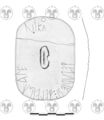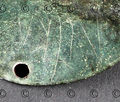NO-3
| Inscription | |
|---|---|
| Transliteration: | φeluriesi : φelvinuale uφiku |
| Original script: | |
|
| |
| Object: | NO-3 plaque (bronze) |
| Position: | back |
| Script: | North Italic script (Sanzeno alphabet) |
| Direction of writing: | sinistroverse |
| Letter height: | 0.90.9 cm <br /> – 1.6 cm |
| Number of letters: | 14 |
| Number of characters: | 15 |
| Number of lines: | 1 |
| Craftsmanship: | engraved |
| Current condition: | complete |
| Date of inscription: | |
| Date derived from: | |
|
| |
| Language: | Raetic |
| Meaning: | 'by of Φelurie son of Φelvi* X-ed' |
|
| |
| Alternative sigla: | PID 210 IR 1 LIR ME-1 |
| Sources: | Schumacher 2004: 150, 336 |
Images
|
Object NO-3 plaque with inscription NO-3.
|
Object NO-3 plaque with inscription NO-3 - rear side.
|
Inscription NO-3 - detail 1 "φeluriesi:".
|
Inscription NO-3 - detail 2 "φelvinuale".
|
Inscription NO-3 - detail 3 "uφiku".
|
Commentary
First published in Pauli 1888: 139 ff.
Images in Pauli 1888: Tav. II,1 (drawing), IR (photo tav. Ia and drawing) = LIR.
Inscribed in two parts on what appears to be the back side of the little votive shield. The first and longer sequence is written in a half-circle along the rim on lower end of the shield (opposite the hole), facing outward. It measures about 13 cm, starting and ending very neatly at the same level (about halfway along the length of the shield). The shorter sequence is inscribed in the same "line", but at a considerable distance from the first group, at the upper end just before and over the hole (length 3.5 cm). The lines are very thin, but all in all well legible.
The longer sequence is fairly neatly executed, although the curve led to some minor problems for the writer. ![]() and
and ![]() are clear.
are clear. ![]() has its bar pointing against writing direction.
has its bar pointing against writing direction. ![]() features a little bar
features a little bar ![]() extending from its right hasta, but a reading
extending from its right hasta, but a reading ![]() can be excluded by comparison with secure
can be excluded by comparison with secure ![]() . (Whatmough somewhat randomly interpreted the bar of
. (Whatmough somewhat randomly interpreted the bar of ![]() and the abovementioned scratch as punctuation marks.)
and the abovementioned scratch as punctuation marks.) ![]()
![]()
![]()
![]()
![]() is unambiguous, the letters becoming successively smaller in the curve. The dots making up the separator are very distinct, being small patches scratched off the surface rather than just indentations. Resuming with bigger letters, now increasing in size:
is unambiguous, the letters becoming successively smaller in the curve. The dots making up the separator are very distinct, being small patches scratched off the surface rather than just indentations. Resuming with bigger letters, now increasing in size: ![]()
![]()
![]()
![]()
![]()
![]() is clear. The area around
is clear. The area around ![]() in the lefthand side curve is damaged by scratches, some unintentional, some maybe stemming from some incertitude on the part of the writer, but
in the lefthand side curve is damaged by scratches, some unintentional, some maybe stemming from some incertitude on the part of the writer, but ![]() can be identified without doubt. Following inverted
can be identified without doubt. Following inverted ![]() may probably also be rated as a mistake due to having to write in a curve; maybe the writer turned the object around to be able to steady his hand on the object. Final
may probably also be rated as a mistake due to having to write in a curve; maybe the writer turned the object around to be able to steady his hand on the object. Final ![]()
![]() is not inverted.
is not inverted.
The shorter sequence is much less tidily inscribed. After ![]() , a wiggly line with a dot on top, executed exactly like the dots making up the separator, is certainly Φ5 s. The line
, a wiggly line with a dot on top, executed exactly like the dots making up the separator, is certainly Φ5 s. The line ![]() , also skew, is prolonged in the bottom, probably a slip if the tool – a short horizontal scratch crossing it in the place where it's supposed to end is probably an effort of the writer to make his intention clear. Final
, also skew, is prolonged in the bottom, probably a slip if the tool – a short horizontal scratch crossing it in the place where it's supposed to end is probably an effort of the writer to make his intention clear. Final ![]() is small and written over the hole.
is small and written over the hole.
The interpretation of the inscription is unproblematic: a standard Raetic name formula in the pertinentive case, followed by a verbal form in -ku. The more interesting question concerns the relation of the two parts of the inscription to each other: A supplementary addition of uφiku might explain its displacement from the name formula, but despite the sloppier execution, the similarity of how the dots were made indicates the same writer. In this case, a co-occurrence of ![]() and Φ5 s is hard to explain and may be taken as an argument against interpreting Φ5 s as a character for a labial, or at least as a variety of Phi. See Φ for a discussion. Note also that another similar dot is found on top of the hasta of the first
and Φ5 s is hard to explain and may be taken as an argument against interpreting Φ5 s as a character for a labial, or at least as a variety of Phi. See Φ for a discussion. Note also that another similar dot is found on top of the hasta of the first ![]() . While the bar of
. While the bar of ![]() , though oriented incorrectly, cannot be disregarded, the dot cannot be excluded to be intentional – possibly a ligature lp? Cp. SZ-14.
, though oriented incorrectly, cannot be disregarded, the dot cannot be excluded to be intentional – possibly a ligature lp? Cp. SZ-14.
Further references: NRIE 90, Battisti 1936b: 598, Battisti 1944: 233 f., Pellegrini 1951: 325 f., Mayr 1959: 230 f., Tibiletti Bruno 1978: 220 f.
Bibliography
| Battisti 1936b | Carlo Battisti, "Rassegna critica degli studi linguistici sull'Alto Adige nel quinquennio 1931-36", Archivio per l'Alto Adige 31/2 (1936), 561–611. |
|---|---|
| Battisti 1944 | Carlo Battisti, "Osservazioni sulla lingua delle iscrizioni nell'alfabeto etrusco settentrionale di Bolzano", Studi Etruschi 18 (1944), 199–236. |
| IR | Alberto Mancini, "Iscrizioni retiche", Studi Etruschi 43 (1975), 249–306. |
| LIR | Alberto Mancini, Le Iscrizioni Retiche [= Quaderni del dipartimento di linguistica, Università degli studi di Firenze Studi 8–9], Padova: Unipress 2009–10. (2 volumes) |
| Mayr 1959 | Karl M. Mayr, "Das Schildchen von Mechel und der Reiter von Sanzeno und ihre Inschriften. Zwei Deutungsversuche", Der Schlern 33 (1959), 230–232. |




